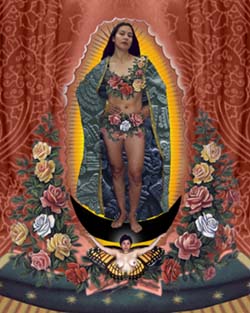Nuestra Señora de Censorship
Who Says the Virgin of Guadalupe Can’t Be Sexy?
By Gustavo Arellano
Orange County Weekly
August 19, 2004
http://www.ocweekly.com/news/news/nuestra-seora-de-censorship/19676/
[See also other
articles by Gustavo Arellano.]
When she appeared to Juan Diego outside Mexico City
in 1531, the Virgin of Guadalupe was dressed in the style of the time:
billowy dress blown about her by some divine wind perhaps and kept in
place by a sash; a splendorous cape flowed from her hair to the ground.
But when it was announced that she might appear at the Fullerton Museum
Center later this month in the style of our times—that’s half-naked—the
Catholic Church went nuts.

And not just the Catholics. Chicano nationalists and museum officials quickly joined the Diocese of Orange in agreeing there would be no naked virgins appearing in Fullerton.
The controversy started on Aug. 1, when Ernesto Cienfuegos, editor of the Chicano nationalist website La Voz de Aztlán (www.aztlan.net), attacked Fullerton Museum Center Director Joe Felz for including "decadent lesbian artist" Alma López in a exhibition titled "The Virgin of Guadalupe: Interpreting Devotion."
López has been the subject of outrage before. Her mixed-media effort Our Lady—a piece re-imagining the Virgin as a sexy Chicana, roses strapped across her breasts and pelvic area, legs and a firm abdomen exposed for all her children to see—provoked demonstrations when it debuted at a Santa Fe art gallery in 2001.
In his e-mail to Felz (which was cc’d to Fullerton Mayor Mike Clesceri and other high-ranking city officials), Cienfuegos wrote that Our Lady "denigrate[s] the values of [Mexicans] in collusion with those in the homosexual and lesbian lifestyles and of those others who have a deep hate against us."
Felz immediately went on the defensive. In a confidential e-mail the following day to those same Fullerton officials, he wrote, "Be assured the information in the e-mail is FALSE. The Museum is NOT showing the controversial piece [Our Lady] as stated by ‘La Voz.’"
Too bad. Felz went on to reveal that the museum would exhibit another Guadalupe-themed López work, María de Los Angeles. That piece—the Virgin fully clothed, generations of women looking on in wonder—looks like a promo for an Edward James Olmos-produced PBS special underscoring the all-American virtues of Latino family life.
María "is in no way derogatory and is meant to indicate the significance of the Virgen de Guadalupe for contemporary female artists," Felz explained. "Ms. López’s personal life and other issues are of no concern to us as a public institution, as they have no mention (or place within the context) of the exhibit."
Felz also revealed that "the Museum has had an Advisory Committee in place for this exhibit from its conception" to ensure that local Latinos wouldn’t be offended. One of committee’s members is Orange diocese Bishop Jaime Soto.
"[The Virgin of Guadalupe] has constantly been reinterpreted for centuries—this is nothing new," Soto told the Weekly. "That’s what makes her so live and vibrant. It’s because of reinterpretation. That’s the beauty. As ancient as it is, it still has more to say. The story of Our Lady didn’t end with the appearance to Juan Diego. . . . To that extent, we’re all part of the story."
Having said that, Soto admitted he isn’t up for López’s version—it’s apparently too racy.
It’s no stretch then to figure that Soto’s opposition to Our Lady played a role in its exclusion from the Fullerton Museum Center’s exhibit. The highest-ranking Latino in the Orange diocese, Soto is the unofficial custodian of Latino Catholic imagery and customs in the county.
"Everyone interprets the image by their own experience and views," counters López. "I try to be truthful to myself and my experiences in what I’m trying to say."
In re-creating a "beautiful and strong" version of Guadalupe with Our Lady, López says she was only following in the footsteps of other Chicano artists who imagined the Virgin as something more than a static image borrowed wholesale from the late Middle Ages. San Diego-based artist Carmen Kalo, for instance, has imagined her as a Zapatista. And in Goddess, University of Arizona professor Alfred Quiroz cloaks a vagina with Guadalupe’s fiery halo.
López says Our Lady was directly inspired by Sandra Cisneros’ 1996 essay "Guadalupe, the Sex Goddess."
"When I see La Virgen de Guadalupe," Cisneros wrote, "I want to lift her dress as I did my dolls’ and look to see if she comes with chones [underwear], and does her panocha [vagina] look like mine, and does she have dark nipples, too? Yes, I am certain she does."
The Fullerton Museum Center doesn’t plan to include those Guadalupe interpretations, either.
Raymond R. Beltrán contributed to this report.
Any original material on these pages is copyright © BishopAccountability.org 2004. Reproduce freely with attribution.